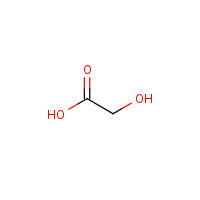Glycolic acid
Agent Name
Glycolic acid
Alternative Name
Hydroxyacetic acid
CAS Number
79-14-1
Formula
C2-H4-O3
Major Category
Other Classes

Synonyms
2-Hydroxyacetic acid; Acetic acid, 2-hydroxy-; Acetic acid, hydroxy-; Glycollic acid; Hydroxyethanoic acid; Kyselina glykolova [Czech]; Kyselina hydroxyoctova [Czech]; [ChemIDplus] UN3261
Category
Organic Acids
Description
Colorless, odorless crystals; [HSDB] Hygroscopic; Commonly available commercially as 70% solution; [ICSC]
Sources/Uses
Used as a cheap organic acid to manufacture adhesives; to dye, print, and crease-proof textiles; to clean metals, water wells, and dairy equipment; and to delime hides and process furs; Also used in leather dyeing, adhesives, electroplating, pH control, copper pickling, printed wire board flux, oil well acidification, biodegradable polymers, soldering compounds, iron chelating, chemical milling, etching lithographic plates, and dermatology; [HSDB] Active product registrations for uses in cleaning products; [NPRIS]
Comments
Corrosive to skin; [Quick CPC] 70% technical solutions cause severe burns of the skin and eyes. [HSDB] Corrosive to skin and eyes; A respiratory tract irritant; May have effects on kidneys, leading to kidney failure; [ICSC] Causes burns; Inhalation may cause corrosive injuries to upper respiratory tract and lungs; Harmful by ingestion; [Alfa Aesar MSDS]
Biomedical References
Exposure Assessment
Vapor Pressure
0.02 mm Hg
Lethal Concentration
LC50 (rat) = 7.1 mg/m3/4hr
Explanatory Notes
LC50 (rat) = 3,600 mg/m3/4hr; [EPA ChAMP] The Guide in the Emergency Response Guidebook is for "Corrosive solid, acidic, organic, n.o.s." VP from HSDB;
NFPA
must be preheated
Adverse Effects
Nephrotoxin
Yes
Dermatotoxin
Skin burns
Diseases, Processes, and Activities Linked to This Agent
Processes
Activities
Activities with risk of exposure: